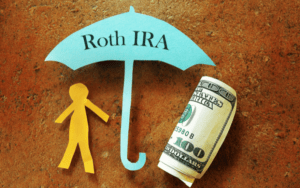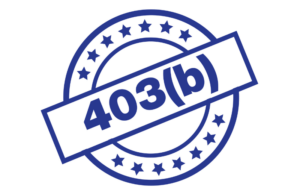Table of Contents
Roth 403b vs Roth IRA
Many people are perplexed by the 403b vs Roth IRA debate. 403b is a type of retirement account to which your employer can contribute.
Simultaneously, a Roth IRA is an investment vehicle for individuals who prefer greater control over their investments and prefer to pay taxes now rather than later (although there are many other factors). In this article we will compare Roth 403b vs Roth IRA and discuss which one may be the better fit for you!
Roth IRA
 A Roth IRA is a type of individual retirement account that enables you to earn money tax-free.
A Roth IRA is a type of individual retirement account that enables you to earn money tax-free.
It was named after Delaware Senator William Roth, who coined the term ‘Roth IRA’ for introducing legislation authorizing conditional IRAs.
Roth IRAs are funded with after-tax income, which means there is no tax deduction at the time of contribution.
However, the money can grow tax-free over time, and withdrawals are also tax-free. If you work, you can contribute to a retirement account with your earnings.
Contribution Restrictions
The contribution limit will increase to $6,000 per year in 2022. Individuals 50 years of age and older may deposit up to $7,000.
Who is not eligible to contribute to a Roth IRA?
If you earn more than $144,000 per year as an individual or more than $214,000 per year as a married couple, you cannot contribute to a Roth IRA.
If you do not earn an income, you are not eligible to contribute to a Roth IRA.
Minimum Distributions Required (RMD)
If you invest in a Roth, there are no required minimum distributions (RMD).
How To Establish A Roth IRA
A Roth IRA account must be opened with an IRS-approved company. This class of financial institutions includes banks, brokerage firms, federally insured credit unions, insurance companies, and savings and loan associations.
You may establish a Roth IRA at any time. However, you must do so prior to the proprietor’s tax filing deadline, which is typically April 15th. After that, you will be unable to obtain an extension.
What Types Of Contributions Are Acceptable?
Roth IRA contributions are limited to earned income.
Employees on Form W-2 – If you are a W-2 employee, the earnings from your job can be used to fund a Roth IRA. Wages, salaries, commissions, and bonuses all qualify.
Self-Employed – If you are self-employed, compensation is defined as the individual’s net earnings from their business, less any deductions for retirement plan contributions made on their behalf, and further reduced by 50% of the individual’s self-employment taxes.
Divorce – Contributions for divorce-related expenses are also accepted. This is referred to as alimony. Child support or money received as part of a settlement can also be deposited in the account.
What Types of Funds Are Ineligible for Contribution:
» The rental income generated by your rental properties
» Profits derived from the sale of a property
» Dividends or interest income generated by investments
» Earnings from retirement plans
Roth IRA for a spouse
A married partner may contribute to their spouse’s Roth IRA. It makes no difference what their income is.
Spousal Roth IRAs are identical to regular Roth IRAs, except that they must be kept separate from one another.
Eligibility:
» Married and filing jointly with your spouse.
» Contributors must use earned income.
» As a household, earn less than $214,000 per year.
Qualified Distributions
You can withdraw funds from a Roth IRA tax-free and penalty-free. If you withdraw only what you put in, the money is not taxable and no penalties apply. This is what is referred to as a qualified distribution.
If you have a Roth account and wish to withdraw money penalty-free when you reach retirement age, you must do so at least five years after the first deposit. And the funds must be released under one of the following conditions:
When owners withdraw funds from their Roth IRA, they must be at least 59. Distributed assets must be used to purchase, construct, or reconstruct a first home. This is a once-in-a-lifetime opportunity for $10,000.
After a person becomes disabled, they may distribute their Roth IRA. The beneficiary of a Roth IRA owner’s account will receive the funds following the owner’s death.
The Five-Year Rule
When you make a withdrawal from your account, the funds may be taxed. The percentage taxed will vary according to your age.
If you have complied with the five-year rule, there is no tax or penalty associated with withdrawing funds from your account.
You’ve waited a minimum of five years:
Earnings of those under the age of 59 are taxed and penalized at a 10% rate (Early Withdrawal Penalty). If you use the funds to purchase your first home, you may be able to avoid paying taxes and penalties.
Additionally, you can avoid taxes if you are disabled or die. 59 years of age and older: There are no taxes. There are no penalties.
You have not waited a minimum of five years:
Earnings of those under the age of 59 are taxed and penalized at a 10% rate (Early Withdrawal Penalty).
You can avoid penalties if you use the funds to purchase your first home. Additionally, you can avoid penalties if you are disabled, die, or use the withdrawal to pay for qualified education expenses.
59 years of age and older: You are remitting taxes while avoiding penalties.
Distributions That Are Not Qualified
If you withdraw funds from your Roth account prematurely, you may be subject to tax and a 10% penalty. The following are the exceptions:
Medical expenses that are not reimbursed. If you use the money to pay for medical expenses that exceed 10% of your annual income, it is acceptable.
If an individual loses their job, they may be required to pay for medical insurance. The withdrawal is intended to be used for qualified higher education expenses.
This includes tuition, fees, books, supplies, and equipment necessary to enroll in or attend an eligible institution.
If you withdraw within one year of giving birth or adopting, you may receive up to $5,000 for your pregnancy or adoption.
Conversion to Roth
Roth IRA conversions enable owners of traditional IRAs to convert their accounts to Roth IRAs. As a result, investors can:
Pay taxes on their tax-deferred savings now and continue to earn tax-free interest. Additionally, they receive tax-free income upon retirement. Withdraw their contributions tax-free at any time. In the future, avoid required minimum distributions (RMD).
403(b) Plan
 Organizations, non-profit employees, and public-school employees may participate in a 403(b) plan.
Organizations, non-profit employees, and public-school employees may participate in a 403(b) plan.
This type of retirement account enables participants to save for retirement tax deferred.
These plans, which were introduced in 1958, can only invest in tax-sheltered annuity (TSA) or tax-deferred annuity (TDA) contracts.
Limits on Contributions and Elective Deferrals
Contributions to 403(b) plans are identical to those to 401(k) plans. Employee contributions to a 403b plan are pre-tax, and thus reduce your adjusted gross income.
Annual contribution limits will increase to $19,500 in 2021 and to $20,500 in 2022. The special catch-up contribution is $6,500 for workers over the age of 50.
Special catch-up contribution provisions known as the lifetime catch-up provision, or 15-year rule are available in 403(b) plans.
Employees with at least 15 years of service are eligible for this benefit, which provides an additional $3,000 payment per year. However, this provision includes a $15,000 lifetime employer-by-employer cap.
Employers may match additional contributions, but the combined employer and employee contributions cannot exceed $57,000 in 2020 or $58,000 in 2021.
Employers can choose between after-tax and Roth contributions. Automatic contributions are one of the benefits of 403(b) plans, but employers have the option of opting out.
Participants in certain types of qualified plans may also be eligible for tax benefits.
The IRS applies the following order to 403(b) contributions made to an individual:
service with elective deferral provision for catching up (15 years) Contribution for those over the age of 50
Rollovers pursuant to Section 403(b)
Employees who change employers can take their plans with them. They can transfer their balances to another 403(b), a 401(k), an annuity, or, in some cases, a self-directed IRA.
A significant advantage of a 403(b) plan is that it can be carried over from job to job rather than being abandoned by a previous employer.
Distributions pursuant to Section 403(b)
Once you reach the age of 59 years, you can begin taking distributions from your 403b plan without incurring tax penalties.
The early withdrawal penalty on an account that is less than 59 years old is 10%. Distributions are subject to ordinary income taxation.
Roth distributions are tax-free, but employees must contribute to the plan or maintain an open Roth IRA for a minimum of five years prior to receiving tax-free distributions.
When you reach the age of 72, you must begin taking RMDs. Failure to make a required minimum distribution result in a 50% excise tax on the amount that should have been withdrawn.
You may be eligible for a loan from your 403(b) plan (b). The loan cannot exceed $50,000 or half of the balance in your retirement plan. If the loan is not repaid within five years, it becomes taxable income.
The IRS receives notification of all distributions via Form 1099-R, which is mailed to plan participants.
Limited Investment Opportunities
Investment options are limited in a 403(b) plan, depending on the investment provider. Custodial accounts can be used to invest in annuities or mutual funds.
How To Spend a Roth IRA Efficiently During Retirement?
After meeting the Roth IRA requirements, an owner may convert their account to a Roth annuity with a lifetime income rider.
The annuity will then continue to distribute tax-free income for the remainder of the retiree’s or married retiree’s life, even after the Roth IRA runs out of funds.
Younger investors can contribute to a new Roth IRA annuity or convert their traditional IRAs to a Roth IRA annuity, thereby ensuring future tax-free income during retirement.
How To Effectively Spend A 403(B) Plan
Employees cannot access their 403(b) plans without incurring a tax penalty until they reach the age of 59 years.
At that point, the owner of a 403(b) plan may convert it to a deferred annuity with a lifetime income rider.
The annuity will then distribute a percentage of the retirement account equally over the remainder of the retiree’s or married retiree’s lifetime, even if the retirement account runs out of money.
What Do My Beneficiaries Receive in the Event of My Death?
Both a Roth IRA and a 403(b) plan will provide a straightforward death benefit equal to the account value of the retirement plan in a lump sum.
If you wish to leave money to your beneficiaries, life insurance may be a better choice. You may not be required to undergo a medical examination in certain circumstances.
Request a free life insurance quote to determine whether you are eligible for affordable coverage. Monthly premiums start at less than $10. Profits are also tax-free!
Hopefully now you are more educated in making your retirement plan decision when choosing a Roth 403b vs Roth IRA plan.
